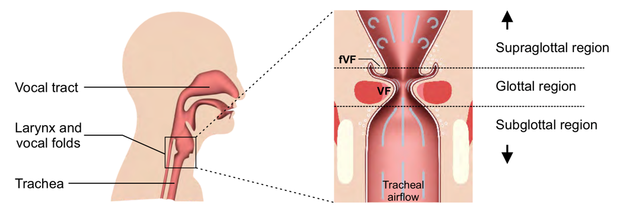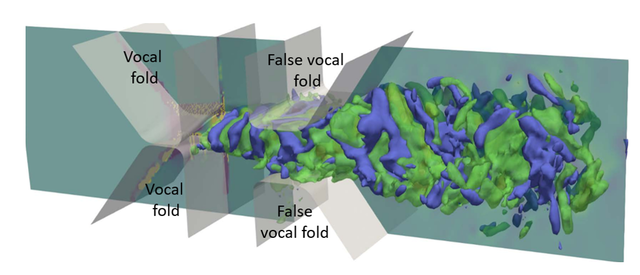Numerical computation of the human voice source
This project is funded by the Austrian Science Fund (FWF) and is in cooperation with Friedrich-Alexander Universität Erlangen-Nürnberg in Germany being funded by German Research Foundation (DFG).
The voice, the carrier signal of speech, is modulated by pharynx constrictions, tongue motion and oral-nasal area. The process of voice production can be described by the interaction between the tracheal airflow and the two elastic vocal folds (VF) inside the larynx that oscillate periodically (see Fig. 4).

Figure 4: Sagittal view of the upper airways (left) and coronal section of a human larynx (right) with vocal folds (VF), ventricular (false vocal) folds (fVF).
Thus, the two oscillating vocal folds (usually at about 120Hz for male and 240Hz for female) interrupt the expiration air stream periodically forming the primary acoustic voice signal. It is the prevailing assumption that for a healthy primary voice signal the VF vibrations need to fulfill three conditions: (1) The VFs have full contact during the oscillations, i.e. the gap between the VFs is temporary fully closed during an oscillation cycle; (2) the VFs oscillate symmetrically; (3) the VFs oscillate periodically. The primary generated voice signal is further modulated within the vocal tract and emitted from the mouth resulting in the audible voice. We use our voice permanently and take it for granted. However, the exact causalities between airflow, vocal fold dynamics, and resulting acoustic signal are still not fully understood.
Our central objective is to develop an aeroacoustic computational model simVoice for clinical applicability. The incompressible flow computation using a LES (Large Eddy Simulation) turbulence model is based on prescribed vocal fold oscillations identified by in-vivo high-speed imaging. In this way the fluid-solid interaction problem, whose accuracy critically depends on reliable geometrical and material parameters of all layers of the vocal folds, is circumvented. According to a perturbation ansatz, the acoustic model is based on the perturbed convective wave equation with the substantial derivative of the incompressible pressure as a source term. The final numerical model simVoice will be made available for scientific and clinical colleagues, and will enable to judge the effectiveness of therapy techniques, help to suggest changes of existing therapy or even help to support development of new therapy approaches. Currently, a main investigation is the analysis of the acoustic sources in the larynx and especially the changes due to organic dysphonia and post-surgery states. Figure 5 displays the acoustic source terms of a healthy voice at an instant of time when the vocal folds are fully open.

Figure 5: Source terms within the larynx
Publications:
- S. Falk, S. Kniesburges, S. Schoder, B. Jakubaß, P. Maurerlehner, M. Echternach, M. Kaltenbacher, M. Döllinger. “3D-FV-FE Aeroacoustic Larynx Model for Investigation of Functional Based Voice Disorders”. Journal Front. Physiol. (2021), https://doi.org/10.3389/fphys.2021.616985
- S. Schoder, A. Wurzinger, C. Junger, M. Weitz, C. Freidhager, K. Roppert, and M. Kaltenbacher. “Application limits of conservative source interpolation methods using a low Mach number hybrid aeroacoustic workflow”. Journal of Theoretical and Computational Acoustics, (2020), https://doi.org/10.1142/s2591728520500322
- S. Schoder, K. Roppert, and M. Kaltenbacher. “Postprocessing of Direct Aeroacoustic Simulations Using Helmholtz Decomposition”. AIAA Journal (2020), https://doi.org/10.2514/1.J058836
- S. Schoder, K. Roppert, M. Weitz, C. Junger, and M. Kaltenbacher. “Aeroacoustic source term computation based on radial basis functions”. In: International Journal for Numerical Methods in Engineering, (2020), https://doi.org/10.1002/nme.6298
- H. Sadeghi, S. Kniesburges, S. Falk, M. Kaltenbacher, A. Schützenberger, and M. Döllinger. “Towards a clinically applicable computational larynx model”. Applied Sciences, (2019), https://doi.org/10.3390/app9112288
- S. Schoder, M. Weitz, P. Maurerlehner, A. Hauser, S. Falk, S. Kniesburges, M. Döllinger, and M. Kaltenbacher. “Hybrid aeroacoustic approach for the efficient numerical simulation of human phonation”. The Journal of the Acoustical Society of America, (2020), https://doi.org/10.1121/10.0000785
- H. Sadeghi, M. Döllinger, M. Kaltenbacher, and S. Kniesburges. “Aerodynamic impact of the ventricular folds in computational larynx models”. The Journal of the Acoustical Society of America 145.4 (2019), doi.org/10.1121/1.5098775
Period
- 2019 - 2021
Funding
- FWF
Members
Manfred Kaltenbacher
Tel.: +43 (0) 316 / 873 – 7250
Email
